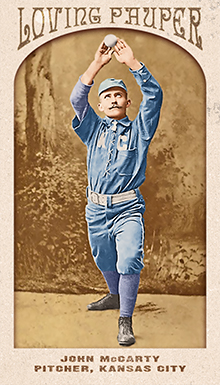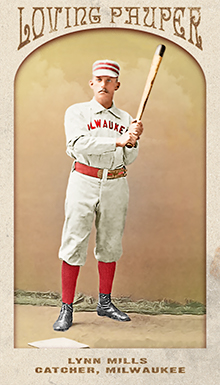
- Series: 1880s: Loving Paupers
- City: St. Paul
- Team: Apostles
- League: Western Association
Willard Eben Mains (1868-1923) had only a few brief appearances in the majors as a pitcher. He was 1-1 with the Chicago White Stockings of the National League in 1888 after starting in pro ball with Portland of the New England League the previous season. He returned to the minors in the Western Association and would go on to a successful career in the lower echelons, winning 318 while losing 179. In 1891 Grasshopper got a little longer opportunity with the American Association's Cincinnati Kelly's Killers and Milwaukee Brewers where he went 12-14. It would be another five years before his last shot in the big time, with Boston's Beaneaters in '96, where he was 3-2.
Mains, also known as Willie, was a product of one of the oldest families in his native Maine. He came out of Windham and would make a name for himself manufacturing bats. He had at least three factories in Sandy Creek, Harrison and Fryeburg, but marketed his product nationally. A Mains Dolley 31” bat circa 1890s recently sold for $400.
- Over his entire 20-year career in professional baseball, Mains played for 17 teams. He stayed in upstate New York for his final decade, closing out his tenure with the Binghamton Bingoes in 1906 after two lengthy tours with the Rome Romans and Syracuse Stars
- Willard inspired his son Jim to pursue careers in both baseball and bats. James R. Mains played first for Harvard in 1942 and got one appearance in the majors, with the Athletics, in August '43 where he lost his only start. Jim established his bat-making operation in Bridgton, Maine
- Perhaps it was his pedigree as a scion of the Down Easters that prompted the Old Judge photographer to record Grasshopper's surname as "Maines" on his St. Paul Apostles card series
Auction History
Cartophilia
Old Judge Pose: 290-2

- Series: 1880s: Loving Paupers
- City: Kansas City
- Team: Blues (WA)
- League: Western Association
John A. McCarty (1867-1942) pitched in professional baseball for five years with one season in the majors. McCarty began at age 20 with the Emporia Reds of the Western League, starting eight games (tied for the most on the team that brief stint) and losing six despite a team-leading 2.92 ERA. He moved to the WL’s Kansas City Cowboys later in the year and went 3-2 on a large roster led by Kid Nichols who starred in his first professional season with an 18-12 record. The following year KC joined the Western Association as the Blues. They clearly liked what they had seen in ‘87 and retained McCarty for the ‘88 campaign. The young hurler rewarded the franchise with an excellent year, winning 21 games against 11 losses with a 2.42 ERA. Despite the 21 wins, Kid Nichols outshone McCarty again, winning 16 of his 18 games pitched with a remarkable 1.14 ERA. True to its decade, with leagues evolving and franchises morphing, 1889 found McCarty with a major league team without changing his address. He now pitched for the Kansas City Cowboys of the American Association. Unfortunately for John and his team, genuine big league competition exposed good minor league players. Nichols was in Omaha pitching to a 39-8 record, the Cowboys sank to seventh in the league and McCarty saw limited duty in just 15 games, winning eight and losing six with a 3.91 ERA in his lone major league campaign. He was demoted to the WA’s St. Joseph Clay Eaters for the remainder of ‘89 where he did start 15 games, but won only five. He had one more try with the Detroit Wolverines in their International Association incarnation in 1890, achieving a 9-9 record in a truncated season.
- BaseballReference.com records McCarty was on the roster for the 1891 KC Blues of the WA, but he appeared in only one game, giving up twelve hits and eight runs (two earned) in six innings and earning a no decision
Auction History
Cartophilia
Old Judge Pose: 302-3

- Series: 1880s: Loving Paupers
- City: Pittsburgh
- Team: Alleghenys
- League: National League
Alexander J. McKinnon (1856-1887) was a remarkably talented player who was cut down in his prime by a scourge of the 19th century, typhoid fever. The tragedy was even more poignant inasmuch as McKinnon had endured numerous illnesses in his youth that had prevented him from really beginning what was on its way to a very fine career. As if sickness wasn't enough of a hardship for young Alex, he was also hindered in the beginning of his pro tenure by league politics and evolving contractual arrangements. He had begun playing for the Syracuse Stars in 1877, staying in NY with Albany/Rochester for the '79 season before heading west to the San Francisco Athletics of the California League in 1880. This move was precipitated by a squabble that involved William Hulbert of the new National League. Alex was assigned to the Troy Trojans for the 1879 season, but wanted to play for Rochester of the International League. Despite some back-room dealings that should have cleared up the controversy, Hulbert expelled McKinnon. A combination of illness that plagued him lifelong and this contract dispute seems to have led him to make the move west and then drop out of baseball altogether for a few years. Clearly McKinnon's talent was recognized and Hulbert relented, allowing Alex to be signed for the '83 season by the Philadelphia Quakers - but the young man was too sick to play. Finally, in 1884, the New York Gothams (not yet the Giants) signed Alex and he began a belated major league tenure that showed tremendous promise. Indeed, in the four short years he played for three NL teams - NY, St. Louis and Pittsburgh - Alex steadily improved his batting average. He hit .272 for the Gothams, jumped to .294 and .301 with the Maroons and was hitting a stunning .365 in 1887 when he was stricken with an ailment he couldn't lick, typhoid. After his mid-season death, the Alleghenys honored Alex by donning black crepe for the duration of that campaign.
- McKinnon was not just a good and ever-improving batter, he became a star in the field. He led the NL in fielding percentage in 1885 with a .978 record. This was all the more striking given his difficulty at first base for the Gothams the prior year when he made 53 errors. Clearly this star-in-training was a quick study
Auction History
Cartophilia
Old Judge Pose: 315-1

- Series: 1880s: Loving Paupers
- City: Milwaukee
- Team: Creams
- League: Western Association
George William McVey (1865-1896) had a much-traveled professional career in baseball, almost all of it in the minors. He played for 20 different franchises beginning in 1884 with the Chillicothe Logans of the Ohio State League and ending with the Quincy Browns of the Western Association in 1895. Along the way he made stops in the Southern League/Association, Tri-State, Texas-Southern, Central Interstate, Pacific Northwest/Interstate and Ohio-Michigan Leagues. George’s sole chance to see action in the major leagues came with the Brooklyn Grays of the American Association in 1885. He played catcher and first base for Brooklyn, but only got into six games where his .143 average led to his return to the minors. That same season saw “Big George” back in Atlanta where he caught the attention of The Sporting News who reported on September 23 that he had “made quite a reputation as a catcher and outfielder in the Southern League.” The sturdy McVey stood 6’1” and, by the end of his career, was known for his size as noted in another Sporting News item from August, 1895: “Big George McVey is playing a good game at first . . . and is hitting at a four hundred gait.” Tragically, this would be his last and best ball. He was reported in April ‘96 to be suffering bowel troubles. He died the following month in Quincy, Illinois.
- A clue to McVey’s peripatetic sojourn in baseball comes from a report in the Milwaukee Sentinel on May 9, 1889 where it was stated that George and Creams teammate Billy Klusman “were released for getting on a spree in St. Joseph.” If this was indicative of a dissolute lifestyle, McVey would hardly be the first of his era’s players to succumb to the temptations and deprivations of the times that shortened far too many careers
Auction History
Cartophilia
Old Judge Pose: 321-3

- Series: 1880s: Loving Paupers
- City: Milwaukee
- Team: Creams
- League: Western Association
Lynn Mills (1862-1937) was a native of Whitewater, WI. He moved to nearby Milwaukee to begin his professional baseball career with the Brewers in 1886. The team was also known as the Cream Citys or Creams after the distinctive local bricks made from a light-colored clay. We lack data on Mills' rookie season, but his performance in '87 was very positive. He batted .290, splitting time as a reserve at short and third. In 1888 the club transitioned from the Northwestern League to the Western Association and Lynn stayed with them through the '89 campaign. He got more playing time, but his average subsided a bit to .260 in '88 and .266 in '89. The following year Mills moved way out west to play for Spokane in the Pacific Northwest League where he had his most prolific year in all offensive categories. He hit .284 and had 103 base hits including 14 doubles as the regular catcher, a position he had played in Milwaukee. Sketchy minor league records indicate Mills returned to the midwest for the 1891 season with the Terre Haute Hottentots of the Northwestern League, but individual stats aren't available. Baseball Reference even shows him returning to Spokane, this time with the Indians of the Pacific National League in 1903, where the then 41-year-old is on the roster but with no record of positions played or batting statistics. It seems unlikely that Mills would have remained out of pro ball for a decade after showing good promise at the plate, especially for a catcher. It also seems unlikely that a youngster of his talent would have had no professional experience prior to age 24, when he is first shown to be with the Cream Citys. Sadly, extant minor league statistics leave too many gaps in our knowledge of the real contributions of stalwarts such as Lynn Mills.
- The Goodwin editors assert that Mills struggled with his defense in Milwaukee to the extent that, for the 1889 season, he ranked next-to-last in the Northwestern League in defense among catchers. Nevertheless, his ability to hit consistently would have assured him a job behind the plate for many teams in an era that devoured receivers who braved the job with little protective equipment
- Mills enjoys six known poses in the Old Judge canon
Auction History
Cartophilia
Old Judge Pose: 326-1




